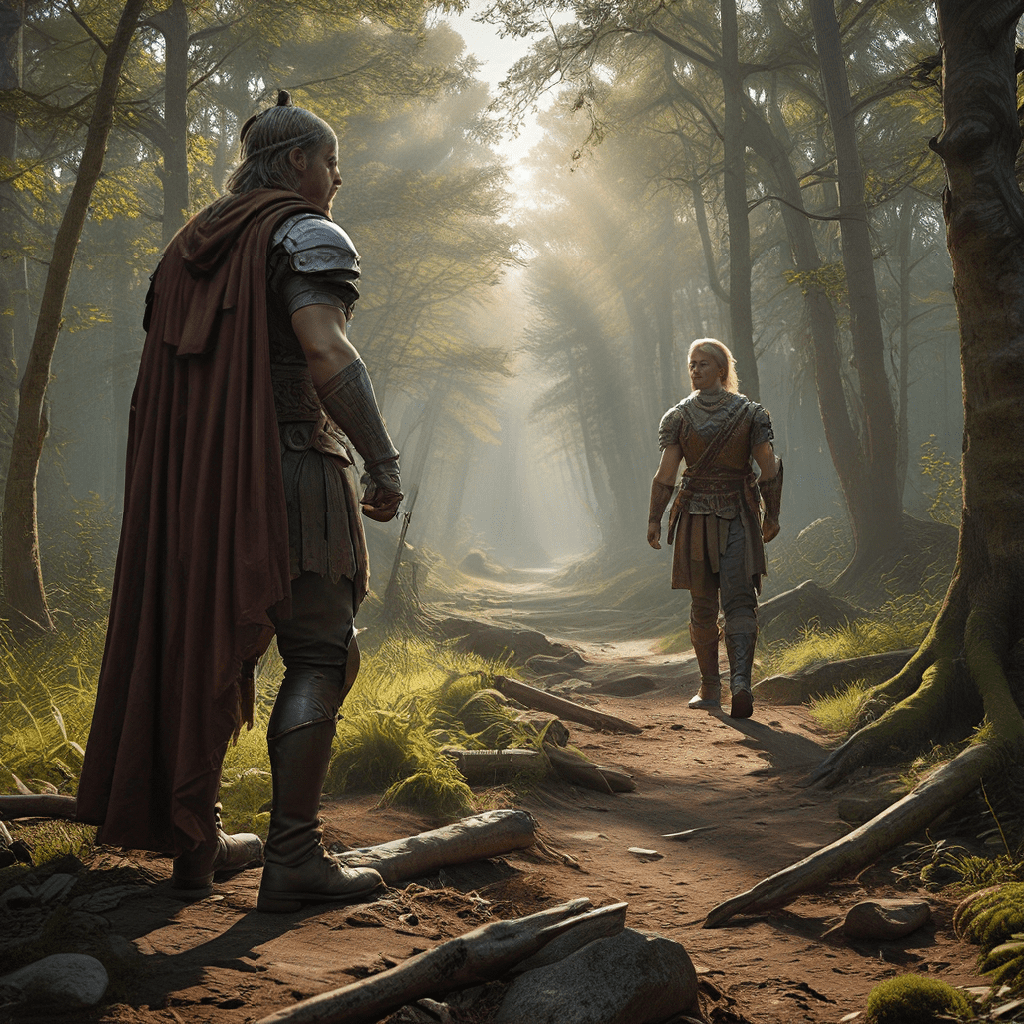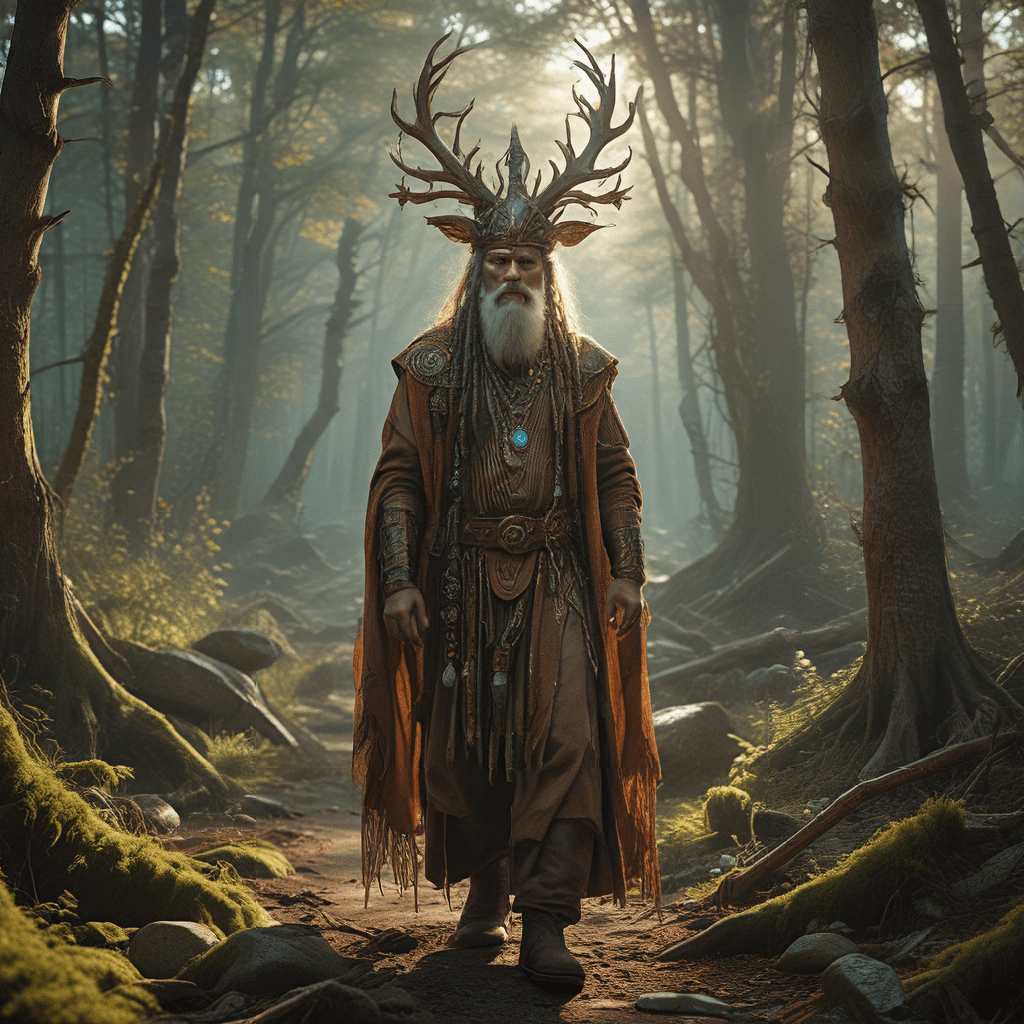Baltic Mythology: A Brief Overview
Baltic mythology, a rich tapestry of ancient beliefs and legends, offers a fascinating glimpse into the worldviews of the Baltic peoples, encompassing cultures like the Latvians, Lithuanians, and Prussians. This mythology, passed down through generations in oral traditions, reflects their close relationship with nature, their understanding of the cosmos, and their values. Central to these beliefs are powerful deities, often personified as forces of nature.
The most prominent figure is Dievs, the sky god, representing the heavens and order. Alongside him stands Perkūnas, the thunder god, who embodies strength and justice. These deities interacted with mortals, influencing their lives and shaping their destinies. Alongside them existed a diverse pantheon, including goddesses like Laima, the goddess of fate, and Velnias, the embodiment of evil, who often challenged the heroes.
Baltic mythology is also permeated by a deep connection to nature, with spirits residing in forests, rivers, and mountains. These spirits, which could be benevolent or malicious, played a significant role in shaping the lives of humans. The connection to the natural world underscores the importance of respect and harmony between humans and the environment.
Heroic Figures and their Attributes in Baltic Myths
Baltic myths are populated by a diverse cast of heroes, figures who exemplify courage, strength, and wisdom. These heroes are often demigods or mortals who possess extraordinary abilities, granted by the gods or earned through their own deeds.
One of the most prominent figures is Aivars, a demigod known for his extraordinary strength and bravery. His exploits include slaying monstrous serpents, rescuing damsels in distress, and vanquishing evil forces. Another notable figure is Jānis, a folk hero whose exploits are rooted in everyday life. Jānis is known for his cleverness, resourcefulness, and ability to outsmart adversaries.
These heroes are often characterized by their physical prowess, but they also embody moral strength. They defend the weak, uphold justice, and embody the ideals of their communities. They are not merely warriors, but also examples of how to live a virtuous life.
The Divine Role in Shaping Heroes
Baltic mythology emphasizes the influence of the gods on the lives of heroes. Often, heroes receive divine gifts, such as magical weapons or superhuman strength, which empower them to overcome challenges. These gifts are often a reward for bravery, piety, or service to the gods.
The gods can also play a more direct role in the lives of heroes, offering guidance, protection, or even participating in battles alongside them. The hero's relationship with the gods is often a crucial element in their success.
However, the divine intervention is not always benevolent. The gods can also test the heroes, setting them challenging tasks or exposing them to dangers. These trials serve to test the hero's character and ultimately shape them into the individuals they are destined to become.
The Role of Monsters and Challenges in Defining Heroism
Baltic myths are filled with terrifying creatures, representing the dangers and challenges that heroes must confront. These monsters, often embodiments of chaos and evil, test the heroes' courage, strength, and ingenuity.
Mythical serpents, monstrous wolves, and powerful giants are just a few examples of the creatures that heroes must overcome. These encounters highlight the hero's bravery and commitment to protecting the innocent. By confronting these challenges, heroes prove their worth and earn the respect of their communities.
The monsters themselves are not simply obstacles, but also reflections of the fears and anxieties of the people. By confronting and defeating these creatures, heroes offer hope and reassurance to their communities, demonstrating that even the most formidable threats can be overcome.
The Significance of Courage and Self-Sacrifice
Courage is one of the most central values in Baltic mythology, and it is often demonstrated through self-sacrifice. Heroes are willing to put their lives on the line to protect their loved ones, their communities, and their values.
This willingness to sacrifice is evident in numerous myths, where heroes face immense danger, knowing they might not survive. These acts of self-sacrifice highlight the importance of duty, loyalty, and the well-being of the community over individual survival.
These acts of self-sacrifice are not merely acts of bravery, but also acts of love and compassion. They demonstrate the hero's willingness to relinquish their own happiness for the greater good, making them exemplary figures for their communities.
Social Responsibility and the Hero’s Duty
Baltic heroes are not simply individualistic figures who chase personal glory. They carry a deep sense of responsibility towards their communities, acting as protectors and guardians. Their actions are often motivated by a desire to maintain order, defend the innocent, and ensure the well-being of their people.
Heroes like Aivars, with their superhuman strength, often confront threats that endanger entire villages. They battle monstrous creatures, restore balance to the natural world, and quell conflicts, ensuring their communities can thrive. Their actions are not driven by personal gain but by a deep-rooted desire to protect those under their care.
This sense of responsibility extends beyond physical threats. Heroes are also expected to uphold societal values and traditions. They embody the ideals of courage, integrity, and justice, setting an example for others to follow. Their actions serve as a reminder of the importance of moral conduct and community cohesion.
The Transformation of Heroes: From Mortal to Mythical
The stories of Baltic heroes often transcend the boundaries of reality, evolving from tales of real individuals into mythical figures. Through the process of storytelling and oral tradition, heroes are embellished, their deeds exaggerated, and their characters idealized.
This transformation is a testament to the heroes' impact on their communities. Their actions, often perceived as extraordinary, become woven into the fabric of culture, shaping the values and traditions of their people. As generations pass, the stories become less about historical fact and more about moral lessons and cultural ideals.
The hero's transformation into a mythical figure also signifies their immortality. Their stories ensure that their deeds and values are remembered and passed down through generations, inspiring and guiding future generations.
The Influence of Baltic Heroes on Folklore and Culture
Baltic heroes have left an indelible mark on the folklore and cultural identity of the region. Their stories are embedded in numerous folk songs, dances, and rituals, serving as a vital part of the collective memory of the people.
The exploits of heroes like Aivars and Jānis continue to be recounted in modern times, reminding people of their ancestors' bravery, resilience, and resourcefulness. These stories offer valuable lessons about the importance of courage, perseverance, community responsibility, and the triumph of good over evil.
The influence of heroes is not just limited to folklore. The names, attributes, and myths associated with these figures have inspired works of art, literature, and music, reflecting the enduring power and relevance of these tales.
Heroic Archetypes in Baltic Mythology
Baltic mythology exhibits distinct heroic archetypes, recurring patterns that reflect the values and aspirations of the people. These archetypes offer insights into the social, cultural, and spiritual beliefs of the Balts.
One prominent archetype is the "Mighty Warrior," exemplified by figures like Aivars. These heroes are characterized by their physical strength, bravery, and unwavering determination to protect their communities. They often possess supernatural abilities, allowing them to overcome formidable foes and achieve seemingly impossible feats.
Another important archetype is the "Clever Trickster," often represented by Jānis. These heroes are known for their wit, resourcefulness, and ability to outsmart their enemies. Their stories often involve challenges that require ingenuity and cunning, showcasing the importance of intellect and strategic thinking.
These archetypes highlight the diverse qualities valued within Baltic society, emphasizing the importance of both physical prowess and mental agility. They serve as models of ideal conduct, inspiring individuals to develop their skills and contribute to the well-being of their communities.
Modern Interpretations of Baltic Heroism
In contemporary society, the concept of heroism continues to evolve and be reinterpreted. Modern interpretations of Baltic heroes often reflect the changing values and perspectives of society.
For example, the traditional emphasis on physical strength and military prowess may be challenged by a growing appreciation for intellectual achievement, social activism, and humanitarian efforts. Modern narratives may explore the heroism of individuals who stand up against injustice, champion equality, or dedicate their lives to serving others.
Despite these shifts in understanding, the core values associated with Baltic heroes – courage, self-sacrifice, and community responsibility – remain relevant. These values continue to inspire individuals to strive for the betterment of themselves and their communities, fostering a sense of collective purpose and shared commitment to positive change.
FAQ
Q: What are some of the most famous Baltic heroes?
A: Some of the most famous Baltic heroes include Aivars, Jānis, and the legendary King Mindaugas.
Q: What are the key attributes of a Baltic hero?
A: Baltic heroes are typically characterized by their courage, strength, wisdom, and unwavering commitment to their communities.
Q: What role did the gods play in the lives of Baltic heroes?
**A: **The gods often influenced the lives of heroes by bestowing upon them special gifts or challenges, shaping their journeys and destinies.
Q: How do Baltic heroes influence modern culture?
A: Their stories continue to inspire artists, writers, and musicians, providing valuable lessons about courage, community, and the importance of upholding moral values.
Q: What are some examples of modern interpretations of Baltic heroism?
A: Modern interpretations of heroism may involve individuals who champion social justice, dedicate themselves to humanitarian causes, or exhibit exceptional intellectual or creative achievements.



